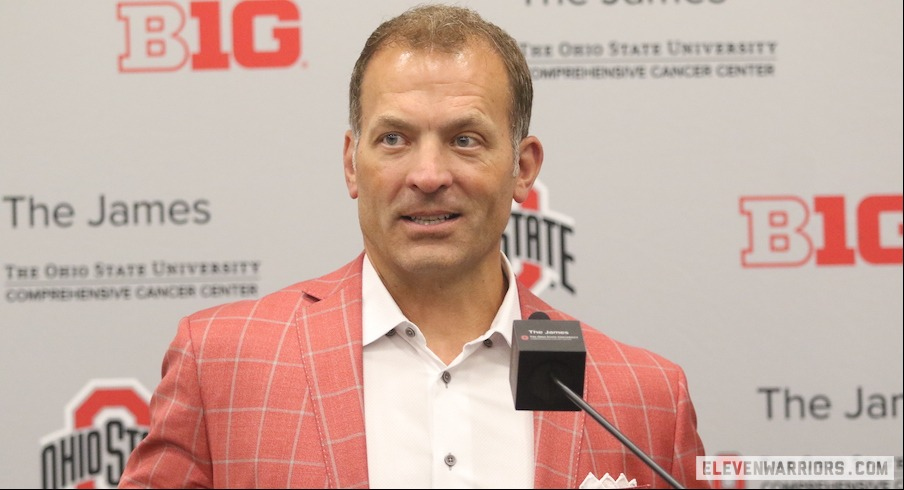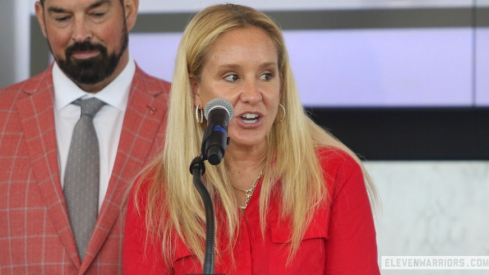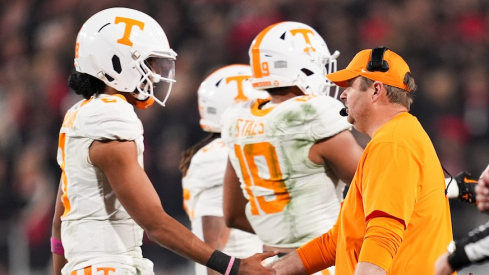New Ohio State athletic director Ross Bjork doesn’t know exactly how the new revenue-sharing model in college sports will work yet, but he’s confident Ohio State will come up with a plan that leads to continued success for its three dozen sports teams.
With one year to go until colleges begin sharing revenue with their athletes in 2025-26, there are still more questions than answers about how exactly the model will work. Bjork says Ohio State is being honest with its coaches, athletes and recruits about the fact that there will likely be changes to how the athletic department allocates resources as a result, but that it remains uncertain exactly what those changes will look like.
“We don't have clarity yet on how much we get allocated per sport. We don't have clarity on is it a financial aid agreement, is it a separate agreement? We don't have clarity on NIL. But we're recruiting the NIL environment and what that new environment could look like,” Bjork said Wednesday. “We're recruiting kids and we have commitments for kids in the class of '25, we have commitments in the class of '26 for a lot of our sports, and right now all we can tell them is, 'Look, your scholarship parameters, your financial aid parameters may be this today, but they will look different in some manner whenever we might sign those papers or whenever you step foot on campus.'”
One of the biggest points of uncertainty surrounding the new model is how Title IX will apply to revenue sharing. An official from the U.S. Department of Education told ESPN on Tuesday that Title IX will apply to revenue sharing, but declined to offer specifics on whether that means schools will have to share the same amount of revenue with male and female athletes.
Ohio State will do whatever it is required to do to comply with Title IX, Bjork said, but he says it’s still “to be determined” exactly what that will mean.
“There's a lot to unpack there,” Bjork said. “Title IX is a federal law. We will follow that. How that's interpreted as it relates to revenue sharing is to be determined.
“So there's a lot of things that we're putting on the table right now. There's a lot of analysis. The best thing that we can do right now; hey, let's put everything in the bucket. Let's analyze where we are with all these things. What are the logistics? What's the workload look like moving forward? What are the answers that we don't have yet? And there's probably a lot more than we do have. Title IX allocation and revenue share is one of them. So we'll get a lot of opinions.
”We'll get a lot of legal advice. And then whatever it is, we'll make the right decision based on what we think is the right approach based on the law.”
One thing Bjork and Ohio State do know is that the Ohio State football program will continue to generate more revenue than the rest of its 35 sports combined. As such, providing the best resources possible to the football team will remain the athletic department’s top priority, though Bjork says Ohio State still wants to keep all of its other sports competitive.
“Everybody knows football drives the economic engine,” Bjork said. “Everybody realizes that, whether you're a softball coach, a golf coach, a baseball coach. So I think what it takes here is you have to have those coaches that embrace football. Look what (Ohio State men’s tennis coach) Ty Tucker does. He embraces the football culture. Guess what? He has support. He's a winner. He knows how to coach at a high level.
“So then it comes down to, look, we want all of our athletes, no matter the sport, to feel like they have the same experience. Nutrition, athletic training, strength and conditioning. Look, we may not have the biggest facility in baseball, but let's make sure it's nice. Same thing in softball. So people know what the equation is around football. They know what that means. But how do we make sure that we provide an experience where we can still compete? And that's what we have to keep doing. And that's what we have to model out as this all kind of comes together.”
Speaking specifically about Ohio State’s baseball and softball programs after formally introducing their new head coaches Justin Haire and Kirin Kumar on Wednesday, Bjork said it’s uncertain how many scholarships will be allocated to those sports when the new model goes into effect. He said Ohio State will be prepared to utilize NIL to help make up for scholarship deficiencies in any sports where it needs to.
There are still a lot of questions that must be answered before Ohio State can make firm plans for how it will allocate its resources in the revenue-sharing era, but Bjork says OSU will figure out what it needs to do to make sure it continues to compete at the highest level.
“We've started a process here where we're evaluating sort of a stratification plan. how are programs funded,” Bjork said. “The revenue share model, we know that's coming. The details are being worked out. But we will fund our programs where we can at least be competitive.
“What that looks like, we don't know yet. How many scholarships are going to be allocated to baseball and softball and what the roster limits are, we don't have all those answers. But it's Ohio State. We'll be on the right side of the equation. It may look differently, whatever that means. But if you believe in the place and in the infrastructure, those things will be worked out, whatever that is."


